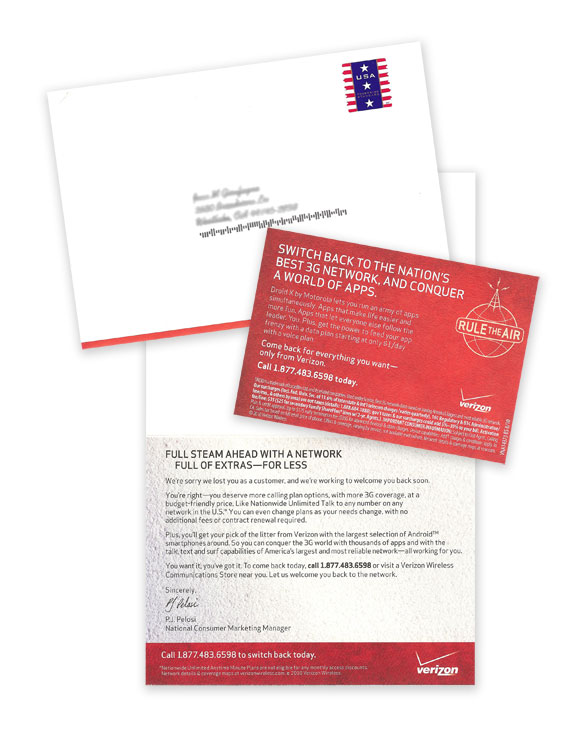How Bad Direct Mail Can Sink a Customer Win-Back Strategy
Verizon says they want me back. But based on the direct mail package they just sent me, I don’t think they mean it.
Reactivating lapsed customers is a smart marketing strategy for every business. It’s easier to reengage a former customer than create a new one.
If you’re using direct marketing to win former customers back, however, you’d better do it right.
Here’s how a major marketer blew a customer win-back opportunity with poor direct mail, and five lessons for more effective win-back direct marketing.
Why It’s Smart to Target Lapsed Customers
It’s an axiom of marketing that it’s easier to sell to a customer than a prospect. Customers know you, and if you deliver a quality product or service, they’re likely to buy again.
It also can be easier to reactivate a former customer than find a new one. There’s less education needed during the sales process. Even more important, you can use the demographic and transactional data you have on former customers to create highly targeted reactivation messages and offers. That’s why data-driven direct marketing is so commonly used in reactivation marketing campaigns.
But Watch What You Mail
But direct marketing to former customers is a tricky business.
Like active customers, inactive customers expect you to know them. When you clearly don’t, you can end up squandering a sales opportunity and reminding people why they left you.
Case in point: Verizon Wireless. We cancelled our family accounts with Verizon last year when we got iPhones from AT&T. But we didn’t leave Verizon just for the iPhone. We consistently had bad experiences with their retail customer service staff and I silently celebrated when I walked out of my local Verizon store for the last time.
 Now Verizon has sent me this direct mail package asking me to come back. It’s true to their new “Rule the Air” marketing campaign, but it breaks several cardinal rules of successful direct marketing:
Now Verizon has sent me this direct mail package asking me to come back. It’s true to their new “Rule the Air” marketing campaign, but it breaks several cardinal rules of successful direct marketing:
- No personalization: The only direct message to me – rather than every other recipient of this campaign – is the address on the envelope, which they had to use to get this promotion to my mailbox. There’s no letter to me and no reference to the number of lines I used to have or the number of years I was a customer.
- No offer: The copy notes their selection of Android smart phones and an insert touts the Droid X. There’s an 877 number I should “call today.” But why? There’s no special deal or price and no deadline, thus no reason for me to come back right now.
- No reference to my local retail store: There’s a Verizon store across the street from my office in Cleveland, Ohio, but there’s no mention of my proximity to this store, no map, and no personal invitation suggesting I come in and meet the unnamed store manager or salesperson who should be waiting to re-engage me.
- Copy that’s irrelevant: The copy says, “You’re right-you deserve more calling plan options, with more 3G coverage, at a budget-friendly price.” But that has nothing to do with why I left Verizon, so there’s a big disconnect between their message and my interests.
- Design that obscures the message: The copy on the inside of the invitation is printed on a patterned image that significantly reduces readability and the insert text is hard to read because it’s reversed out of red.
5 Lessons for Your Smart Marketing Strategy
Here are five marketing lessons from Verizon’s direct marketing mistakes that you can apply to your next win-back direct marketing campaign and your smart marketing strategy:
- Use data to personalize the message. Take advantage of the data you have on former customers to deliver a message tailored to their needs and their experience with you. Use what you know about them to relate to them as only you can.
- Make a compelling offer. Give people a powerful reason to return to you by making an offer they can’t resist.
- Create a deadline for response. Put a timeframe on your offer so respondents have a reason to act now.
- Show former customers they have special status. Give lapsed customers something extra, like a bonus, a premium, a gift, or a special price to which only they are entitled because of their relationship with you.
- Never let design overpower the message. Graphic design always should make it easier, not harder, for people to read, understand, and respond to your message. Your goal is to get a response, not win design awards.





Pingback:Tweets that mention How Bad Direct Mail Can Sink a Customer Win-Back Strategy | Smart Marketing Strategy -- Topsy.com
Craig
Hi Jean,
Another great post. Would you agree that it can be a challenge to determine why customers leave in the first place? Gathering this data at the time of their exit is significant to personalizing the offer on win-back pieces in my opinion.
Craig
jeangianfagna
I agree that knowing why customers leave is essential for successful win-back marketing and that it can be hard to find this out. However, good data mining by Verizon would have revealed that all our lines were transferred to AT&T. If they had used this data, they would have been better off sending direct mail touting the power of the Droid v. the iPhone, which has its shortcomings. Verizon also could have surveyed us and other defecting customers to find out why we left and used that data to drive a more personalized and more relevant message.
Direct Mailing Gaithersburg
your content is very unique and neat also useful
Kathryn Grace
I agree with every one of your points. Apparently, the percentage of response to such a mailing is so great, Verizon and others of their ilk needn’t concern themselves with individual customers at any level.
jeangianfagna
Thanks for your comment, Kathryn. I think it’s an open question whether there would be enough positive response to this campaign to enable Verizon to consider it a winner. The whole effort would be so much more effective if it were personalized to the recipient, especially since they have so much data on the recipient as a former customer.